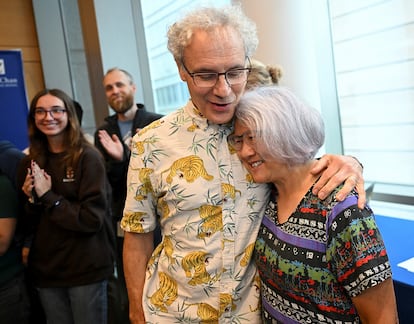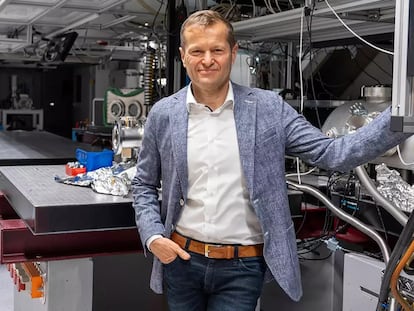Why researcher Rosalind Lee, the wife of the Nobel Prize winner in Medicine, didn’t receive the award as well
The scientist was the first author of the pioneering ‘Cell’ study on microRNA, but it is typically the last author who is recognized as the leader of the research group

On Monday, the Nobel Prize organization posted a message on social media: “Congratulations to our 2024 laureate Victor Ambros. This morning he celebrated the news of his prize with his colleague and wife Rosalind “Candy” Lee, who was also the first author on the 1993 Cell paper cited by the Nobel Committee.” The message included a photo of Ambros and Lee smiling at the camera.
The post has received more than 2.2 million views and hundreds of comments, many from users questioning why Lee did not receive the Nobel Prize alongside her husband. Some comments reference the case of another Rosalind — Rosalind Franklin — and the 1962 Nobel Prize in Medicine. Since the award’s inception in 1901, 227 individuals have been honored, but only 13 women have won. Is the Nobel Committee being unfair to Rosalind Lee? All indications suggest otherwise.
Contrary to popular belief, the first author of a study is not necessarily the most important. Typically, the last author is recognized as the leader of the research group. In the study cited by the Nobel Committee, Lee is listed as the first author, while Rhonda Feinbaum is the second. The study clarifies that both contributed equally to the research.
The fact that Ambros signed as the last author and was the corresponding researcher indicates that he led the work, explains Pilar Martín, a researcher at the National Centre for Cardiovascular Research and an expert in microRNA. “In science, the corresponding author [the one who submits the study to the journal and answers any questions about it] is the individual who devised the experiment; they are the intellectual author of the research. Nobel Prizes are awarded for new ideas that benefit humanity, and in this case, it is clear that Ambros and Ruvkun are the primary contributors,” she asserts.
This is not the first time a Nobel Prize in science has sparked controversy. These awards can only be bestowed upon a maximum of three individuals, which, for many, is the reason why Spaniard Francis Mojica was excluded from the podium in 2020. The two seminal studies from 1993 that detailed the discovery of microRNAs — one led by Ambros and the other by Ruvkun — had a total of six authors involved in the experiments, already exceeding the maximum number of winners. Additionally, the committee considered subsequent studies that included contributions from other authors.
For Martín, the controversy surrounding Lee’s case is merely “noise.” “Biomedical science is not something that can be accomplished alone; it requires a lot of work from many researchers who contribute to the experiments, even if they are not the ones who conceived the research. That’s how science works; you learn to conduct research by executing the experiments designed by your supervisor,” she adds.
Rosalind Lee’s situation is particularly notable, as she has been Ambros’ wife since they co-authored their first paper in 1993, when she was a lab assistant. Throughout her career, Lee has co-authored numerous studies with Ambros. While it may seem that she has been overshadowed by her husband, this is not the case. Within the specialized microRNA community, Ambros and Ruvkun are widely regarded as the pioneers of microRNA research. There are even researchers who have been active in the field for years and remain unaware of Rosalind Lee’s contributions.
The researcher celebrated the award as a collective triumph. “For us, it was mostly that we said, well, we’ve accomplished something,” she said in an interview at the University of Massachusetts, where she is currently a senior researcher in her husband’s group. “We’ve added to the scientific knowledge. I think that’s all scientists want to do, to have their work be something that people can build on and discover things, and the things that people have been able to do in the microRNA field is just astounding.”
In 2008, Ambros and Ruvkun won the prestigious Lasker Award for Basic Medical Research alongside David Baulcombe. In his acceptance speech, Ambros made a very pertinent point about the nature of research. “What I love most about science is that it is such a deeply, intensely human enterprise,” he said. “The success of the enterprise of science, and of the individual scientist, is derived precisely from the fact that we do it together. We work together in synergy as small teams, such as Candy Lee and Rhonda Feinbaum did to discover the first microRNA; we communicate our treasured, secret data across lab borders, as Gary Ruvkun and I did to enable us to discover the antisense base-pairing between microRNAs and targets; and we publish to the world our findings, so that for example, I opened a journal in 1999, and was astonished by a report from David Baulcombe’s group of little RNAs, just like lin-4, way over there in plants.”
This paragraph alone alludes to enough scientists to fill the podium of the Nobel Prize in Science for several years to come.
Bruce Wightman, a researcher at Muhlenberg College in the United States, was the first author of the other seminal study on microRNA in 1993, led by Gary Ruvkun. In an email, the researcher once again makes clear the complex network of collaborations behind each Nobel Prize.
“Science is a collaborative task, and any project is developed over years with many contributors. This discovery was made possible thanks to the work of Marty Chalfie, Bob Horvitz and John Sulston, who won the Nobel Prize for their findings, published since 1981,” he explains.
The scientist emphasizes that a 1984 study published in Science — with Ambros as the first author and Horvitz as the last — paved the way for the collaboration with Ruvkun that ultimately led to another Nobel Prize. In fact, Ambros had believed he would never receive the Nobel Prize himself, as his disciple Craig Mello had already won it for his discovery of interference RNA.
The story gets even more complicated. Wightman asserts that his contribution to the discovery of microRNAs was “central.” It was the basis of his PhD thesis, however, this work relied heavily on the efforts of postdoctoral students Prema Arasu, Thomas Burglin, and Ilho Ha.
In 1958, U.S. biologist Joshua Lederberg won the Nobel Prize in Medicine along with two other researchers for their studies of bacterial genetics. The jury did not recognize the work of his wife Esther Lederberg, even though she worked in the same field and was the mastermind behind some of the research. “I understand that people wonder about things when the boss’s wife contributes to research,” says Wightman, “but I don’t think that’s the case with Lee.”
In his original will in 1895, Swedish dynamite inventor Alfred Nobel wrote that the prize should go to “the person” who had made the greatest contribution to physics, chemistry and physiology or medicine in the previous year. The three-winner rule was not made official until much later, in 1968. Since then, one in three Nobel Prizes in medicine, physics and chemistry has been shared by three people. The necessity to limit the number of winners means that only those who “inaugurate a new field and sustain it” are selected, as explained by Joseph Goldstein, president of the Lasker jury, in 2016. This rule is becoming increasingly incompatible with the collaborative nature of modern scientific research.
You can write to us at ndominguez@elpais.es
Sign up for our weekly newsletter to get more English-language news coverage from EL PAÍS USA Edition
Tu suscripción se está usando en otro dispositivo
¿Quieres añadir otro usuario a tu suscripción?
Si continúas leyendo en este dispositivo, no se podrá leer en el otro.
FlechaTu suscripción se está usando en otro dispositivo y solo puedes acceder a EL PAÍS desde un dispositivo a la vez.
Si quieres compartir tu cuenta, cambia tu suscripción a la modalidad Premium, así podrás añadir otro usuario. Cada uno accederá con su propia cuenta de email, lo que os permitirá personalizar vuestra experiencia en EL PAÍS.
¿Tienes una suscripción de empresa? Accede aquí para contratar más cuentas.
En el caso de no saber quién está usando tu cuenta, te recomendamos cambiar tu contraseña aquí.
Si decides continuar compartiendo tu cuenta, este mensaje se mostrará en tu dispositivo y en el de la otra persona que está usando tu cuenta de forma indefinida, afectando a tu experiencia de lectura. Puedes consultar aquí los términos y condiciones de la suscripción digital.
More information
Archived In
Últimas noticias
New York enters the era of Zohran Mamdani
Welcome to the post-religion era: The idea of Christianity as the absolute truth has become obsolete
‘I thought you would like it’: The risky sexual practice popularized by TV shows and TikTok
The digitalization of tourism: ‘They promise experiences and gave us the worst possible one’
Most viewed
- Sinaloa Cartel war is taking its toll on Los Chapitos
- Reinhard Genzel, Nobel laureate in physics: ‘One-minute videos will never give you the truth’
- Oona Chaplin: ‘I told James Cameron that I was living in a treehouse and starting a permaculture project with a friend’
- Why the price of coffee has skyrocketed: from Brazilian plantations to specialty coffee houses
- Silver prices are going crazy: This is what’s fueling the rally











































